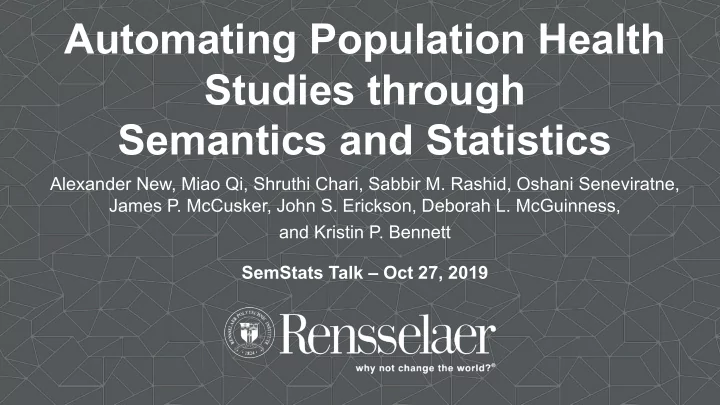

Automating Population Health Studies through Semantics and Statistics Alexander New, Miao Qi, Shruthi Chari, Sabbir M. Rashid, Oshani Seneviratne, James P. McCusker, John S. Erickson, Deborah L. McGuinness, and Kristin P. Bennett SemStats Talk – Oct 27, 2019
Project Summary We use ontologies and knowledge graphs to represent data preparation and workflow modeling in a reusable and reproducible way using Semantically-Targeted Analysis with reusable modular knowledge called cartridges . 2 Making Study Populations Visible through Knowledge Graphs 10/28/19
Use Case For [discovered subpopulation] in [study cohort] , does [risk factor] have a significant association with [chronic health condition] ?. 3 Making Study Populations Visible through Knowledge Graphs 10/28/19
Semantically Targeted Analytics (STA) Framework 4 Automating Population Health Studies through 10/27/2019 Semantics and Statistics
Health Analysis Ontology (HAO) § It supports modeling of processes, components, models, variables and factors involved in a health analysis pipeline § It provides a vocabulary necessary to model the reusable components of an analysis (sio:Analysis) implemented by an analysis workflow (hao:AnalysisWorkflow) that we store in cartridges (hao:Cartridge). § Ontologies currently used in STA 5 Automating Population Health Studies through 10/27/2019 Semantics and Statistics
Cartridges: Application-specific Vocabularies That Extend A KG's Range Of Applicable Analyses Response Variable Model Analysis concepts and background domain axioms necessary to model a given Chosen hyperparameters and optimal health condition model Study cohort Subpopulation Inclusion criteria used to determine if a Summary statistics characterizing given subject may be included in a study discovered subpopulations Risk factor Rules for modeling semantically-similar risk Results factor categories (e.g., pesticides) Statistical quantification of subpopulation-specific discovered Parameter associations between the risk factor and Rules to complete chosen analysis the response variable workflow , such as potential hyperparameter configurations to search over 6 Automating Population Health Studies through 10/27/2019 Semantics and Statistics
Input Cartridges (Yellow): Define Components Of A Risk Study • Cartridges encode best practices for both analytics mode ling and specific domain s • This allows rigorous studies to be constructed, represented, and int erpreted by people with diverse background knowle dge levels 7 Automating Population Health Studies through 10/27/2019 Semantics and Statistics
Output Cartridges (Light Blue) Store Statistical Findings 8 Automating Population Health Studies through 10/27/2019 Semantics and Statistics
Supervised Cadre Models For Subpopulation-discovery And Risk Analysis § Supervised learning framework for heterogeneous data − Simultaneously divides observations into subpopulations (cadres) and learns subpopulation-specific risk models − E.g., subjects below a threshold based on age and BMI have a significant association between blood cadmium and systolic blood pressure § Risk score function (e.g., for having hypertension) § Risk score function for cadre m § Probability that observation x belongs to cadre m § Semimetric used for cadre-assignment 9 Automating Population Health Studies through 10/27/2019 Semantics and Statistics
Example: Identify Risk Factors Associated With High Total Cholesterol Response Parameter Total cholesterol is a Train models with M = Study cohort continuous response 1, 2 and 3 cadres and All available NHANES variable. choose best one using subjects BIC for model selection Response Parameter Control for subjects’ Standardize risk factor Risk Factor age, Body Mass Index measurements 201 environmental (BMI), Poverty Income exposure risk factors Parameter Ratio (PIR),smoking divided into 17 Significance threshold of habits, drinking habits, categories α = 0.02 for GLM gender, marital status, hypothesis tests and education level. 10 Automating Population Health Studies through 10/27/2019 Semantics and Statistics
Example: Identify Risk Factors Associated With High Total Cholesterol • Heatmap of subpopulation means that • Significant positive regression coefficients have significant risk factor associated with associated with high total cholesterol high total cholesterol 11 Automating Population Health Studies through 10/27/2019 Semantics and Statistics
Conclusions Via cartridges , novel STA is a framework statistical findings are for performing end- written to a collective to-end analyses knowledge graph for on semantically- future querying and heterogeneous data reference. 12 Automating Population Health Studies through 10/27/2019 Semantics and Statistics
Questions? Thank You! Points of contact: Alexander New, newa2@rpi.edu Kristin P. Bennett, bennek@rpi.edu Deborah L. McGuinness, dlm@cs.rpi.edu 13 Automating Population Health Studies through 10/27/2019 Semantics and Statistics
Recommend
More recommend